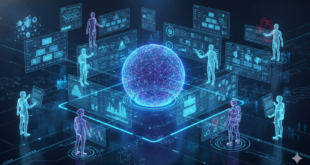Modern military bases face a rapidly evolving set of security challenges driven by their interconnectedness with civilian infrastructure and technological dependence. While bases must maintain and upgrade their own aging infrastructure, they are also heavily reliant on external utilities like electricity and water. This dependency introduces risk, particularly when external …
Read More »The Unbreakable Atom: How Meltdown-Proof Reactors Are Fueling Nuclear’s Comeback
In the quest for a sustainable and secure energy future, renewable sources like wind and solar have rightfully taken center stage. Yet, one often misunderstood and overlooked power source is quietly making a comeback: nuclear energy. Thanks to cutting-edge innovations, including the development of “meltdown-proof” nuclear reactors, nuclear power may …
Read More »Defending the Skies: How Space Weather Sensors Shield Our Vital Assets
The Invisible War Above Us Above our heads, a silent and invisible war unfolds. Every 90 seconds, the Sun ejects massive clouds of plasma—coronal mass ejections (CMEs)—that hurl through space at speeds reaching 7 million miles per hour. These solar storms can release energy equivalent to what humanity consumes in …
Read More »Xi Jinping Calls for High-Tech ‘Smart System’ to Boost China’s Border Defence
Introduction: Technology at the Core of China’s Defence Modernisation President Xi Jinping has issued a renewed call to modernize China’s border security architecture through the deployment of high-tech “smart systems” to confront what he described as “new opportunities and challenges” in national defense. The remarks were delivered during a high-level …
Read More »Forging the Future Battlefield: Key Insights from the 2024 Emerging Technologies for Defense Conference
At the 2024 Emerging Technologies for Defense Conference & Exhibition held from August 7–9 in Washington, D.C., a clear message resonated across sessions: the pace of battlefield innovation is accelerating, and Western militaries must adapt or risk obsolescence. The convergence of commercial ingenuity with military imperatives is collapsing traditional development …
Read More »From Ruins to Resilience: Real-Time Tech and the Hidden Toll of War
The wars of the 21st century—particularly in the Middle East, North Africa (MENA), and Ukraine—have made one fact abundantly clear: assessments of environmental and infrastructure damage cannot wait for peace agreements or ceasefires. These wars have left cities in ruins, destroyed critical public services, and turned once-livable urban centers into …
Read More »The Agentic AI Revolution: Beyond Chatbots to Autonomous Digital Workforce
Rethinking AI: From Tools to Teammates Artificial intelligence is undergoing a dramatic transformation. While generative AI amazed the world with its ability to produce text, images, and code on demand, the next phase is even more groundbreaking: agentic AI. Unlike conventional AI systems that simply respond to inputs, agentic AI …
Read More »Light at the End of the Tunnel: How Photonics is Powering the Climate Fight
As humanity faces the accelerating consequences of climate change—rising temperatures, violent storms, and collapsing ecosystems—the demand for transformative, science-based solutions has reached critical urgency. While global decarbonization efforts often concentrate on energy systems, transportation, or agriculture, a less visible yet profoundly influential field is now emerging at the heart of …
Read More »AI in Drug Discovery: Navigating the Promise of Breakthroughs and the Peril of Chemical Weapons
The field of artificial intelligence has made tremendous strides in drug discovery, offering the promise of revolutionizing medicine and healthcare. However, there is a growing concern that the same AI technology, when placed in the wrong hands, could be used to develop chemical weapons. This article explores two significant advancements …
Read More »The Promise and Perils of Data-Driven Synthetic Biology
Data-Driven Synthetic Biology: When AI Begins to Design Life Itself AI and biology are merging to rewrite the code of life — promising breakthroughs in medicine, energy, and agriculture, but also raising profound ethical and security challenges. Introduction In recent years, synthetic biology has taken a quantum leap forward—thanks in …
Read More » International Defense Security & Technology Your trusted Source for News, Research and Analysis
International Defense Security & Technology Your trusted Source for News, Research and Analysis




